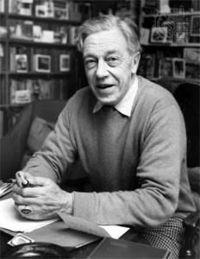
Nicholas Blake is the pseudonym of poet Cecil Day-Lewis C. Day Lewis who was born in Ireland in 1904. He was the son of the Reverend Frank Cecil Day-Lewis and his wife Kathleen (nee Squires). His mother died in 1906 and he and his father moved to London where he was brought up by his father with the help of an aunt.
He spent his holidays in Wrexford and regarded himself very much as anglo-irish, although when the Republic of Ireland was declared in 1948 he chose British citizenship.
He was married twice, to Mary King in 1928 and to Jill Balcon in 1951 and during the 1940s he had a long love affair with novelist Rosamond Lehmann. He had four children from his two marriages with actor Daniel Day-Lewis, documentary filmmaker and television chef Tamasin Day-Lewis and TV critic and writer Sean Day-Lewis being three of his children.
He began work as a schoolmaster and during World War II he worked as a publications editor in the Ministry of Information. After the war he joined Chatto & Windus as a senior editor and director and then in 1946 he began lecturing at Cambridge University. He later taught poetry at Oxford University, where he was Professor of Poetry from 1951-1956 and from 1962-1963 he was the Norton Professor at Harvard University.
But he was by then earning his living mainly from his writings, having had some poetry published in the late 1920s and early 1930s and then in 1935 beginning his career as a thriller writer with 'A Question of Proof', which featured his amateur sleuth Nigel Strangeways, reputedly modelled on W H Auden. He continued the Strangeways series, which finally totalled 16 novels ending with 'The Morning After Death' in 1966. He also wrote four detective novels which did not feature Strangeways.
He continued to write poetry and became Poet Laureate in 1968, a post he held until his death in 1972. He was also awarded the CBE.
He died from pancreatic cancer on 22 May 1972 at the Hertfordshire home of Kingsley Amis and Elizabeth Jane Howard, where he and his wife were staying. He is buried in Stinsford churchyard, close to the grave of one of his heroes Thomas Hardy, something that he had arranged before his death.